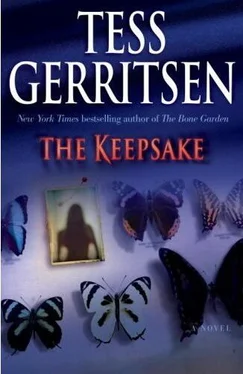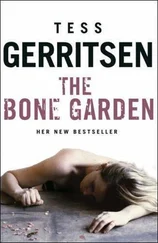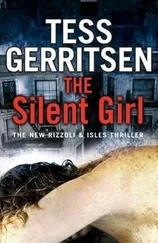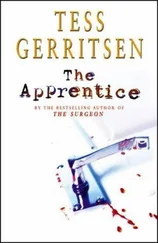“Please keep the door closed, if you could,” said Robinson.
“This is a climate-controlled area.”
“Man,” said Detective Crowe. “This is going to take us forever to look through all of these. What’s in these crates, anyway?”
“We’re more than halfway through our inventory,” said Robinson. “If you’d only give us another few months to complete it, we’d be able to tell you what every crate contains.”
“A few months is a long time to wait.”
“It’s taken me a year just to inspect those rows there, all the way to the back shelves. I can personally vouch for their contents. But I haven’t yet opened the crates at this end. It’s a slow process because one needs to be careful and document everything. Some of the items are centuries old and may already be crumbling.”
“Even in a climate-controlled room?” asked Tripp.
“The air-conditioning wasn’t installed until the 1960s.”
Frost pointed to a crate on the bottom of a stack. “Look at the date stamped on that one. ‘1873. Siam.’”
“You see?” Robinson looked at Jane. “There may be treasures here that haven’t been unpacked in a hundred years. My plan was to go through these crates systematically and document everything.” He paused. “But then I discovered Madam X and the inventory came to a halt. Otherwise, we’d be further along by now.”
“Where did you find her crate?” asked Jane. “Which section?”
“Down this row, back against the wall.” He pointed to the far end of the storage area. “She was at the bottom of the stack.”
“You looked in the crates that were on top of hers?”
“Yes. They contained items acquired during the 1910s. Artifacts from the Ottoman Empire, plus a few Chinese scrolls and pottery.”
“The 1910s?” Jane thought of the mummy’s perfect dentition, the amalgam filling in her tooth. “Madam X was almost certainly more recent than that.”
“Then how did she end up underneath older crates?” asked Detective Crowe.
“Obviously someone rearranged things in here,” said Jane. “It would have made her less accessible.”
As Jane gazed around the cavernous space, she thought of the mausoleum in which her grandmother had been interred, a marble palace where every wall was etched with the names of those who rested within the crypts. Is this what I’m looking at now? A mausoleum packed with nameless victims? She walked toward the far end of the basement, where Madam X had been found. Two lightbulbs overhead had burned out in this area, throwing the corner into shadow.
“Let’s start our search here,” she said.
Together Frost and Crowe pulled the top crate off the stack and lowered it to the floor. On the lid was scrawled:MISCELLANEOUS. CONGO. Frost used a crowbar to pry up the lid, and at his first glimpse of what lay inside, he flinched back, bumping against Jane.
“What is it?” she asked.
Darren Crowe suddenly laughed. Reaching into the crate, he pulled out a wooden mask and held it over his face. “Boo!”
“Be careful with that!” said Robinson. “It’s valuable.”
“It’s also creepy as hell,” murmured Frost, staring at the mask’s grotesque features carved into wood.
Crowe set the mask aside and pulled out one of the crumpled newspapers used to cushion the crate’s contents. “London Times, 1930. I’d say this crate predates our perp.”
“I really must protest,” said Robinson. “You’re touching things-contaminating things. You should all be wearing gloves.”
“Maybe you should wait outside, Dr. Robinson,” said Jane.
“No, I won’t. The safety of this collection is my responsibility.”
She turned to confront him. Mild-mannered though he appeared, he stubbornly stood his ground as she advanced, his eyes blinking furiously behind his glasses. Outside this museum, if confronted by a police officer, Nicholas Robinson would probably respond deferentially. But here on his own territory, in defense of his precious collection, he appeared fully prepared to engage in hand-to-hand combat.
“You’re rampaging through here like wild cattle,” he said.
“What makes you think there are more bodies down here? What kind of people do you think work in museums?”
“I don’t know, Dr. Robinson. That’s what I’m trying to find out.”
“Then ask me. Talk to me, instead of tearing apart crates. I know this museum. I know the people who’ve worked here.”
“You’ve been curator here for only three years,” said Jane.
“I also worked here as a summer intern when I was in college. I knew Dr. Scott-Kerr, and he was utterly harmless.” He glared at Crowe, who had just fished a vase out of the open crate. “Hey! That’s at least four hundred years old! Treat it with respect!”
“Maybe it’s time for you and me to step outside,” said Jane.
“We need to talk.”
He shot a worried glance at the three detectives, who had started opening another crate. He reluctantly followed her out of the basement and up the stairs to the first-floor gallery. They stood by the Egyptian exhibit, its faux tomb entrance looming above them.
“Exactly when were you an intern here, Dr. Robinson?” Jane asked.
“Twenty years ago, during my junior and senior years in college. When William was curator, he tried to bring in one or two college students every summer.”
“Why are there no interns now?”
“We no longer have money in our budget to pay their expenses. So we find it almost impossible to attract any students. Besides, when you’re young, you’d rather be working out in the field anyway, with other kids your age. Not confined to this dusty old building.”
“What do you remember about Dr. Scott-Kerr?”
“I liked him quite a bit,” he said. And a smile flickered on his lips at the memory. “He was a little absentminded even then, but he was always pleasant, always generous with his time. He gave me a great deal of responsibility right off the bat, and that made it the best experience I could have had. Even if it did set me up for disappointment.”
“Why?”
“It raised my expectations. I thought I’d be able to land a job just like it when I finished my doctorate.”
“You didn’t?”
He shook his head. “I ended up working as a shovel bum.”
“What does that mean?”
“A contract archaeologist. These days, that’s pretty much the only kind of job one can get with a fresh archaeology degree. They call it cultural resource management. I worked at construction sites and military bases. I dug test pits, looking for any evidence of historic value before the bulldozers moved in. It’s a job only for young people. There are no benefits, you’re always living out of a suitcase, and it’s damn hard on the knees and back. So when Simon called me three years ago to offer me this job, I was glad to hang up my shovel, even if I’m earning less than I did in the field. Which explains why this position went vacant for so long after Dr. Scott-Kerr died.”
“How can a museum operate without a curator?”
“By letting someone like Mrs. Willebrandt run the show, if you can believe it. She left the same displays in the same dusty cases for years.” He glanced toward the reception desk, and his voice dropped to a whisper. “And you know what? She hasn’t changed a whit since I was an intern. That woman was born ancient.”
Jane heard footsteps thump on the stairwell and turned to see Frost trudging up the basement steps. “Rizzoli, you’d better come down and see this.”
“What did you find?”
“We’re not sure.”
She and Robinson followed Frost back down to the basement storeroom. Spilled wood shavings littered the floor where the detectives had searched through several more crates.
Читать дальше












